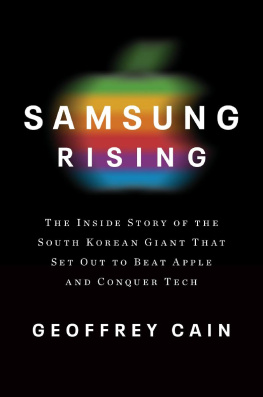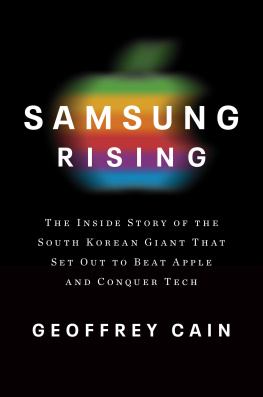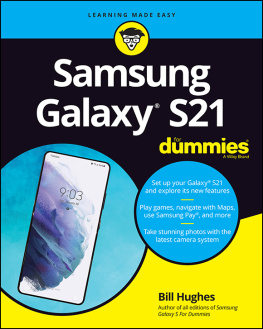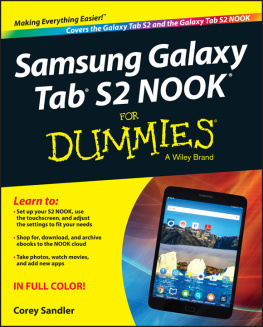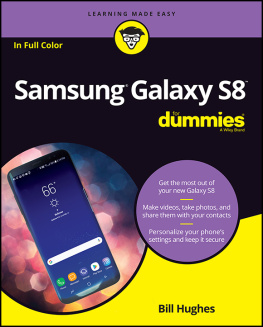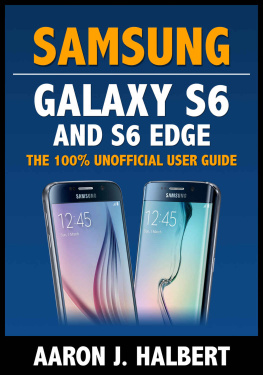Geoffrey Cain - Samsung Rising
Here you can read online Geoffrey Cain - Samsung Rising full text of the book (entire story) in english for free. Download pdf and epub, get meaning, cover and reviews about this ebook. year: 2020, publisher: Crown, genre: Detective and thriller. Description of the work, (preface) as well as reviews are available. Best literature library LitArk.com created for fans of good reading and offers a wide selection of genres:
Romance novel
Science fiction
Adventure
Detective
Science
History
Home and family
Prose
Art
Politics
Computer
Non-fiction
Religion
Business
Children
Humor
Choose a favorite category and find really read worthwhile books. Enjoy immersion in the world of imagination, feel the emotions of the characters or learn something new for yourself, make an fascinating discovery.
- Book:Samsung Rising
- Author:
- Publisher:Crown
- Genre:
- Year:2020
- Rating:4 / 5
- Favourites:Add to favourites
- Your mark:
- 80
- 1
- 2
- 3
- 4
- 5
Samsung Rising: summary, description and annotation
We offer to read an annotation, description, summary or preface (depends on what the author of the book "Samsung Rising" wrote himself). If you haven't found the necessary information about the book — write in the comments, we will try to find it.
Samsung Rising — read online for free the complete book (whole text) full work
Below is the text of the book, divided by pages. System saving the place of the last page read, allows you to conveniently read the book "Samsung Rising" online for free, without having to search again every time where you left off. Put a bookmark, and you can go to the page where you finished reading at any time.
Font size:
Interval:
Bookmark:

Copyright 2020 by Geoffrey Cain
All rights reserved.
Published in the United States by Currency, an imprint of Random House, a division of Penguin Random House LLC, New York.
CURRENCY and its colophon are trademarks of Penguin Random House LLC.
Hardback ISBN9781101907252
International edition ISBN9780593236703
Ebook ISBN9781101907269
randomhousebooks.com
Book design by Debbie Glasserman, adapted for ebook
Photos courtesy of the author unless otherwise noted.
Cover design: Lucas Heinrich
v5.4
ep
Contents
Note on Research, Translations, and Korean Names
I INTERVIEWED MORE THAN four hundred current and former Samsung employees, executives, politicians, businesspeople, board members, journalists, activists, and analysts, as well as a member of Samsungs founding Lee family. Samsung did not cooperate with this book. Most of my interviews were through unofficial channels. Samsung, however, cooperated with my earlier magazine reporting for Time and Fast Company . Those official interviews are included.
The interviews took place in South Korea, Japan, China, New York, New Jersey, Texas, and California. Many interviewees did not want to be named or go on the record. I have respected their wishes. Many graciously offered to help me, knowing their careers were at great risk, and with little benefit to themselves.
Interviews were conducted in Korean, Japanese, and English, depending on the needs of the interviewee. Many Korean figures of speech dont translate fluidly into English. I have double-checked these statements with the subjects to ensure that the original intent was not lost, with the help of my researcher, Max Soeun Kim, talented young Guardian stringer and native Korean speaker.
This book follows no single convention for Korean names. It follows the personal preferences of the people I interviewed and wrote about. Most Koreans prefer the standard usage: family name first, given name second. On second mention, some write their given names as initials. Lee Byung-chul, for instance, becomes B.C. Lee. Sometimes Koreans prefer to hyphenate their given names (Lee Kun-hee). Sometimes they leave out the hyphen (Park Chul Wan). The Revised Romanization system is used throughout.
Researching this book, I used a mixture of investigative journalism and ethnography methods, drawing on my academic background in anthropology. For archival research, I consulted the collections at my graduate-school alma mater, the School of Oriental and African Studies at the University of London, as well as the Presidential Archives and National Assembly Library of Korea.
Cast of Characters
I. THE KOREANS
Chairman Lee Byung-chul (B.C. Lee, also known as Chairman Lee I) (19101987). Founder and first chairman of the Samsung Group, from 1938 until his death in October 1987.
Chairman Lee Kun-hee (K.H. Lee, also referred to as Chairman Lee II) (b. 1942). Son of B.C. Lee and second chairman of the Samsung Group, from 1987 to the present, who transformed Samsung into a global nameplate brand. He suffered a heart attack in May 2014 and has not been seen in public since.
Vice Chairman Lee Jae-yong (Jay Y. Lee, tapped to become Chairman Lee III) (b. 1968). Son of K.H. Lee and heir apparent to the Samsung empire, he was sentenced to five years in prison for bribery and embezzlement. Released early from prison on appeal, a panel of judges upheld but lessened the extent of his bribery conviction. He awaits retrial after Koreas Supreme Court voided his second ruling, and may be sent back to prison with possibly expanded charges.
Lee Maeng-hee (19312015). Oldest brother among B.C. Lees three sons. He was the favored heir to the Samsung Group before he resigned in 1969, accused by his father of mismanagement.
Lee Mie-kyung (Miky Lee). Daughter of Lee Maeng-hee, niece of Samsung chairman Lee Kun-hee, and Samsungs emissary to the U.S. entertainment and design industries before leaving to start her own production house, CJ Entertainment, in a partnership with DreamWorks.
Hong Jin-ki (19171986). Samsung founder B.C. Lees political ally and former head of Samsungs JoongAng newspaper . His family forged an alliance with Samsungs founding Lee family. His daughter Hong Ra-hee married Samsung chairman K.H. Lee.
President Park Chung-hee (19171979). Dictator of South Korea starting with his military coup dtat in 1961 and ending with his assassination in 1979. He laid the economic and political foundation for the Korean economic miracle, bolstering companies like Samsung and Hyundai.
President Park Geun-hye. Daughter of dictator Park Chung-hee. As the democratically elected president of South Korea from 2013 to 2017, she was implicated in organizing almost $38 million in bribes from Samsung for her political ally. President Park was removed from office and jailed in March 2017.
Lee Ki-tae (K.T. Lee). No relation to the ruling Lee family. K.T. Lee was the CEO of Samsung Electronics mobile phone unit from 2000 to 2007. He started out as a factory floor manager; as CEO of Samsungs mobile phone unit, he elevated the quality and durability of Samsung mobile phones and brought them to the U.S. market.
Hwang Chang-gyu. President of Samsungs semiconductors unit from 2004 to 2008, and chief technology officer of Samsung Electronics from 2008 to 2010. Hwang made a key deal with Apples Steve Jobs in 2005 to supply chips for the iPod and later the iPhone, spurring Samsungs explosive growth.
Choi Gee-sung (G.S. Choi). Formerly the powerful lieutenant to Samsungs ruling Lee family and head of the Future Strategy Office, Samsungs highest body that houses many of the elite executives, known as the Tower. Now serving a five-year prison sentence for bribery and embezzlement.
Shin Jong-kyun (J.K. Shin). CEO of Samsungs mobile unit from March 2013 to December 2015. He oversaw the kick-starting of the Galaxy smartphone line and helped to initiate the smartphone wars against Apple.
Koh Dong-jin (D.J. Koh). Successor to J.K. Shin and CEO of Samsungs mobile unit from December 2015 to the present. He oversaw the recall and cancellation of the Galaxy Note 7 after the product began catching fire.
Sohn Dae-il (Dale). CEO of Samsung Telecommunications America from 2006 to August 2013. He helped lead the smartphone wars against Apple.
II. THE AMERICANS
Peter Arnell. Hired by Chairman Lee II to bring cutting-edge, fashion-based advertising to Samsung products in the mid-1990s, when the company was known as a manufacturer. Former head of the Arnell Group in New York.
Gordon Bruce. Design professor at ArtCenter in Pasadena, California. Co-founder of the Innovative Design Lab of Samsung (IDS) from 1995 to 1998.
Pete Skarzynski. Vice president for sales and marketing at Samsungs American unit from 1997 to 2007. With K.T. Lee, he brought Samsung mobile phones to the American market.
Eric Kim. Executive vice president and then chief marketing officer at Samsung Electronics from 1999 to 2004. Through his branding and advertising campaigns, Samsung overtook Sony in brand value and sales by the mid-2000s.
Todd Pendleton. Chief marketing officer at Samsungs American mobile unit from 2011 to 2015. Led advertising efforts against Apple during the Samsung-versus-Apple smartphone wars.
Daren Tsui and Ed Ho. Two Silicon Valley entrepreneurs who got their start working with Elon Musk and later sold their music software, mSpot, to Samsung in May 2012. After the sale, they joined Samsung as vice presidents for content and services; they ran the grand experiment Milk Music until its closure in September 2016.
Paul Elliott Singer. Founder and CEO of Elliott Management, an ultrasecretive hedge fund in New York. Known to many in the industry as the Vulture. He challenged Samsung in court and in shareholder votes as the company set out to install its heir, Jay Lee, as the next chairman.
Next pageFont size:
Interval:
Bookmark:
Similar books «Samsung Rising»
Look at similar books to Samsung Rising. We have selected literature similar in name and meaning in the hope of providing readers with more options to find new, interesting, not yet read works.
Discussion, reviews of the book Samsung Rising and just readers' own opinions. Leave your comments, write what you think about the work, its meaning or the main characters. Specify what exactly you liked and what you didn't like, and why you think so.

